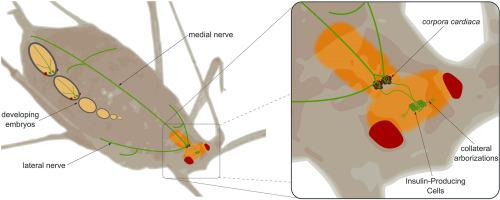Insect Biochemistry and Molecular Biology ( IF 3.8 ) Pub Date : 2021-07-09 , DOI: 10.1016/j.ibmb.2021.103623 Paolo Cuti 1 , Miquel Barberà 1 , Jan A Veenstra 2 , David Martínez-Torres 1

|
Aphids were the first animals described as photoperiodic due to their seasonal switch from viviparous parthenogenesis to sexual reproduction (cyclical parthenogenesis) caused by the shortening of the photoperiod in autumn. This switch produces a single sexual generation of oviparous females and males that mate and lay diapausing cold-resistant eggs that can overcome the unfavourable environmental conditions typical of winter in temperate regions. Previous studies have hinted at a possible implication of two insulin-like peptides (ILP1 and ILP4) in the aphid seasonal response, changing their expression levels between different photoperiodic conditions. Moreover, in situ localization of their transcripts in particular neurosecretory cells (NSCs) in the aphid brain supported the idea that these neuropeptides could correspond to the formerly called virginoparin, an uncharacterized factor originally proposed to be transported directly to the aphid embryos to promote their development as parthenogenetic individuals. To further investigate the fate of these ILPs, we raised a specific antiserum against one of them (ILP4) and mapped this neuropeptide by immunohistochemistry (IHC) in Acyrthosiphon pisum and Megoura viciae aphids. Coincident with in situ localization, our results show that ILP4 is synthesized in two groups (one in each brain hemisphere) of four neurosecretory cells in the pars intercerebralis (NSC group I) and then it is transported outside the brain to the corpora cardiaca. From there, three nerves (two laterals and one medial) transport it to the abdomen. Although no precise site of release has been found, the terminations of these nerves near the germaria would be compatible with the proposal of a direct connection between group I of NSCs and the reproductive system by localized release. In addition, we detected some collateral arborizations originating from the eight NSCs going to the pars lateralis, where clock neurons and some photoreceptors have been previously localized, suggesting a possible communication between the circadian and photoperiodic systems.
中文翻译:

蚜虫类胰岛素肽的表征进展:ILP4的免疫组化图谱
蚜虫是第一个被描述为光周期动物,因为它们在秋季光周期缩短导致从胎生孤雌生殖到有性生殖(周期性孤雌生殖)的季节性转换。这种转换产生单性一代的卵生雌性和雄性,它们交配并产下滞育抗寒卵,可以克服温带地区冬季典型的不利环境条件。先前的研究暗示了两种胰岛素样肽(ILP1 和 ILP4)在蚜虫季节性反应中的可能影响,在不同光周期条件下改变它们的表达水平。此外,就地它们转录物在蚜虫大脑中特定神经分泌细胞 (NSCs) 的定位支持了这样的观点,即这些神经肽可能对应于以前称为 virginoparin 的物质,这种未表征的因子最初被提议直接运输到蚜虫胚胎以促进它们作为孤雌生殖个体的发育。为了进一步研究这些 ILP 的命运,我们针对其中一个 (ILP4) 提出了一种特定的抗血清,并通过免疫组织化学 (IHC) 在Acyrthosiphon pisum和Megoura viciae蚜虫中绘制了这种神经肽。与原位定位一致,我们的结果表明,ILP4 在大脑间隙的四个神经分泌细胞的两组(每个大脑半球一个)中合成(NSC组I),然后将其输送大脑到外部语料库cardiaca。从那里,三条神经(两条外侧和一条内侧)将其输送到腹部。尽管尚未发现精确的释放部位,但这些神经在geraria附近的末端与通过局部释放将第I组NSC与生殖系统直接连接的提议相一致。此外,我们检测到一些源自于进入外侧部的 8 个神经干细胞的侧枝分支,其中时钟神经元和一些光感受器先前已定位,这表明昼夜节律和光周期系统之间可能存在通信。


























 京公网安备 11010802027423号
京公网安备 11010802027423号